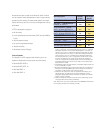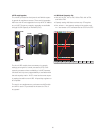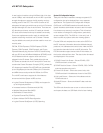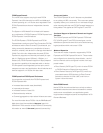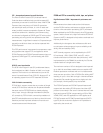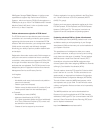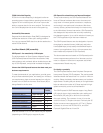A new host bus interface using Infi niBand with a link data
rate of 6 GBps, was introduced on the z10 BC. It provides
enough throughput to support the full capacity and pro-
cessing power of the CPC. The z10 BC contains an I/O
subsystem infrastructure which uses up to four I/O drawers
that provides eight I/O slots in each drawer. There are two
I/O domains per drawer, and four I/O cards per domain.
I/O cards are horizontal and may be added concurrently.
Concurrent replacement and/or repair is available with
systems containing more than one I/O drawer. Drawers
may be added concurrently should the need for more con-
nectivity arise.
ESCON, FICON Express4, FICON Express2, FICON
Express, OSA-Express3, OSA-Express2, and Crypto
Express2 features plug into the z10 BC I/O drawer along
with any ISC-3s and Infi niBand Multiplexer (IFB-MP) cards.
All I/O features and their support cards can be hot-
plugged in the I/O drawer. Each model ships with one
I/O drawer as standard in the A-Frame (the A-Frame also
contains the Central Processor Complex [CPC]), where the
I/O drawers are installed. Each IFB-MP has a bandwidth
up to 6 GigaBytes per second (GB/sec) for I/O domains
and MBA fanout cards provide 2.0 GB/sec for ICB-4s.
The z10 BC continues to support all of the features
announced with the System z9 BC such as:
• Logical Channel Subsystems (LCSSs) and support for
up to 30 logical partitions
• Increased number of Subchannels (63.75k)
• Multiple Subchannel Sets (MSS)
• Redundant I/O Interconnect
• Physical Channel IDs (PCHIDs)
• System Initiated CHPID Reconfi guration
• Logical Channel SubSystem (LCSS) Spanning
System I/O Confi guration Analyzer
Today the information needed to manage a system’s I/O
confi guration has to be obtained from many separate
applications. The System’s I/O Confi guration Analyzer
(SIOA) tool is a SE/HMC-based tool that will allow the
system hardware administrator access to the information
from these many sources in one place. This will make it
much easier to manage I/O confi gurations, particularly
across multiple CPCs. The SIOA is a “view-only” tool. It
does not offer any options other than viewing options.
First the SIOA tool analyzes the current active IOCDS on
the SE. It extracts information about the defi ned channel,
partitions, link addresses and control units. Next the SIOA
tool asks the channels for their node ID information. The
FICON channels support remote node ID information, so
that is also collected from them. The data is then formatted
and displayed on fi ve screens:
1)PCHID Control Unit Screen – Shows PCHIDs, CSS.
CHPIDs and their control units
2)PCHID Partition Screen – Shows PCHIDS, CSS. CHPIDs
and what partitions they are in
3)Control Unit Screen – Shows the control units, their
PCHIDs and their link addresses in each of the CSS’s
4)Link Load Screen – Shows the Link address and the
PCHIDs that use it
5)Node ID Screen – Shows the Node ID data under the
PCHIDs
The SIOA tool allows the user to sort on various columns
and export the data to a USB fl ash drive for later viewing.
z10 BC I/O Subsystem
18



